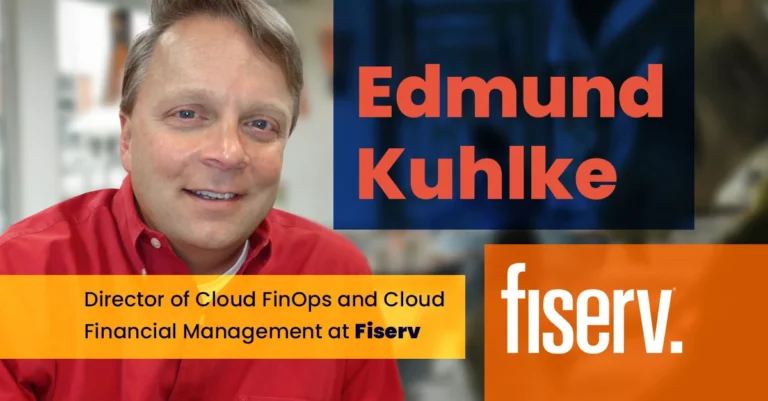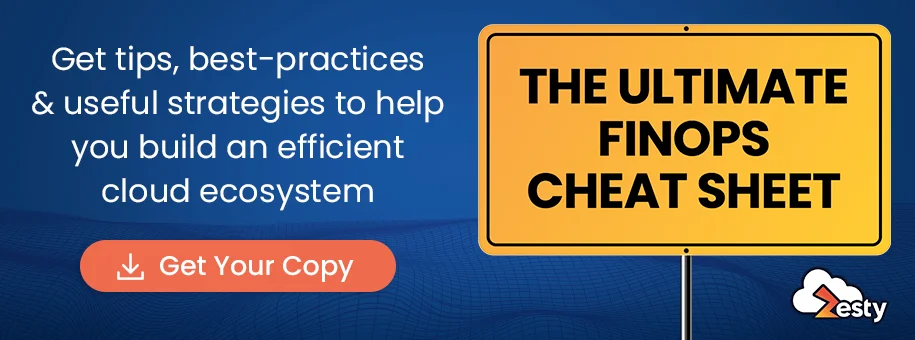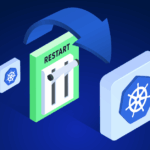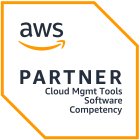
What is FinOps? An Interview with a Cloud Financial Expert

CEO and Co-founder
We’ve been focusing a lot on FinOps lately–sharing everything from starting your FinOps journey, to building your FinOps dream team, to top FinOps challenges and more.
But what is FinOps and what is it like to actually work in this field? What does the average day look like? What are the responsibilities? What qualifications do you need to be successful?
We sat down with Edmund Kuhlke, Director of Cloud FinOps and Cloud Financial Management at Fiserv to find the answers to all these questions and more.
Check out his insights below.
What does a typical day look like?
- Rolling out cloud financial and costing solutions for AWS, Azure, and Google
- Standardizing cost approaches across all providers and integrating into existing internal financial processes (eg, chargeback)
- Vendor management
- “Plumbing” (bills, POC, etc.)
- Working/interacting with other IT teams
- Creating a FinOps playbook to optimize costs (includes guidelines such as using RIs and SPs, right sizing, consistently turning off unused servers, etc.)
As the designated financial guy on the technical team, I need to put cloud financial processes in place, manage costs, and make sure application owners are accountable for the costs they incur.
This is challenging because Fiserv works in a multi-cloud environment, and as a result, I needed to come up with a cloud agnostic approach which takes into account various pricing and architectural differences. Then, I needed to ensure that costs are allocated correctly for every business unit. At Fiserv, we do this by assigning unique application IDs to cloud accounts/subscriptions/projects in order to link costs to the responsible owners.
What background is well-suited for FinOps?
FinOps professionals come from a variety of different backgrounds and areas of expertise.
For example, I studied Industrial Engineering in school. With this background, I learned about the practice of building processes and adapting them as conditions change. I also work as an intermediary/“translator” between management and technical roles and have learned how to communicate between these two (often opposing) teams. In this role, I embraced processes and standards and developed new approaches to improve existing processes.
This served me well as I eventually broke into FinOps — which is all about applying a financial way of thinking to the cloud, building financial processes , serving as a go-between for both financial and technical teams, and providing financial oversight to cloud stakeholders.
In my experience, more FinOps professionals come from a technical background as it is easier for a technical person to learn finance than the other way around.
How mature is your FinOps team?
Today, I am part of a FinOps team of one. This is a challenge because I’m responsible for allocating costs for hundreds of applications. To make this work, my strategy involves integrating FinOps practices into our daily financial practices and making it a part of our standard cloud cost optimization tools. In other words, my goal is to integrate FinOps into our cloud’s DNA and structure FinOps solutions around company culture.
What are your FinOps KPIs?
There are many KPIs that can be used to measure FinOps success. If we were to pick a single KPI at Fiserv to measure optimization success it would be the savings (both absolute and percentage) generated from our good FinOps habits. Nothing communicates to upper management better than money saved.
Two particularly useful KPIs that I visit frequently are the utilization and coverage of our RIs and SPs. For example, I target a specific percentage of EC2 instances that are always covered by RIs and SPs. If they come out lower than this number, I review the data to understand the root cause behind the result and work to correct it. Zesty has really helped us a lot here, from a utilization KPI perspective, Zesty has helped us achieve a near 100% utilization of all of our Reserved Instance commitments. Using Commitment Manager we have significantly cut our spend to our cloud provider.
How do you work with technical teams on reducing cloud costs?
With our cloud deployments, Fiserv has hundreds of applications and business owners. In order to manage this, I prioritize my relationships with business partners. I do not tell them how to do their job (i.e. what servers or platform to use). But rather, I emphasize actions that can be deemed as common sense and mutually beneficial. Furthermore, since every application team has a specific budget, cloud engineers are naturally incentivized to adjust their infrastructure for “easy wins” in order to keep costs low.
For example, if we see a large number of servers going unused in a Test or Dev environment, we can enable our internal auto-parking tool to ensure that they are powered down after hours. In this case, I can communicate this cost savings (up to 75%, by the way) with the application team responsible. Since they’d usually prefer that budget to be spent elsewhere, they are generally willing to turn off these unused servers.
What makes a FinOps practitioner successful?
First and foremost, what makes a FinOps person successful is building a solid line of communication with application owners. It is up to FinOps practitioners to educate technical teams so they understand the financial ramifications of their infrastructure decisions long before they get to the point of being over budget.
FinOps must also be able to successfully and repeatedly create cloud financial processes that are scalable. In many companies (like Fiserv), this means processes that operate across multiple cloud vendors. It also means keeping an eye on the market to see what solutions are available to help you automate more manual processes. This was one of the major reasons why we decided to deploy Zesty, as the solution enabled us to automate the manual monitoring and adjustment of our cloud spend. Freeing up our DevOps team so they no longer had to check our cloud spend has been of major value.
They need to constantly stay ahead of their cloud spend, creating proactive solutions that keep costs down and be in the know about every dollar being spent.
What’s the biggest mistake you’ve made since you started in FinOps?
The biggest mistake I’ve made since working in FinOps was not fully understanding my business environment. In a specific example, I was unaware that a particular business unit was going to increase its cloud spend by 160% in a single month
When the bill arrived, it was a huge surprise for all–and not in a good way.
In retrospect, I think we could have built a better relationship with this particular business owner. This way, I could have understood his plans, and ensured he understood the financial impact. Additionally, we could have looked for a solution that optimized the cost.
What’s an important tip you’d give to those interested in FinOps?
For anyone getting into FinOps, industry conferences are a great opportunity to meet other people in the cloud business and educate yourself on the latest best practices. After all, there’s no one better to educate a FinOps newbie than by getting to know the people who live and breathe it every day.
In addition, reading cloud optimization and costing books and blogs (like the FinOps Foundation and others) is an effective way to better understand the techniques and strategies to build cloud financial success in your organization.
Lastly, look into tools like Zesty, that take out a lot of the grunt work of managing the cloud. Since deploying Zesty’s commitment manager, I haven’t looked back. The seamless integration with our back end, and the fact that it just works as it should, shedding any excess commitments from our account, has made it a critical element of our cloud ecosystem.
Final words
That’s a wrap! We hope you enjoyed reading these expert perspectives from Fiserv’s resident FinOps master. Special thanks to Edmund Kuhlke for chatting with us and providing us with his vast knowledge and experience.
Interested in learning more about FinOps? Check out our FinOps toolset or contact one of our cloud experts to learn how Zesty can help you automate your FinOps processes.

Related Articles
-
 Zesty now supports In-Place Pod Resizing for Seamless, Real-Time Vertical Scaling
Zesty now supports In-Place Pod Resizing for Seamless, Real-Time Vertical Scaling
July 30, 2025 -
 The endless cycle of manual K8s cost optimization is costing you
The endless cycle of manual K8s cost optimization is costing you
July 2, 2025 -
 Why major Kubernetes monitoring vendors miss the mark on cost visibility
Why major Kubernetes monitoring vendors miss the mark on cost visibility
February 27, 2025 -
 Rethinking CPU Utilization Practices
Rethinking CPU Utilization Practices
January 21, 2025 -
 How FastScale Technology Optimizes Kubernetes Deployments
How FastScale Technology Optimizes Kubernetes Deployments
January 2, 2025


